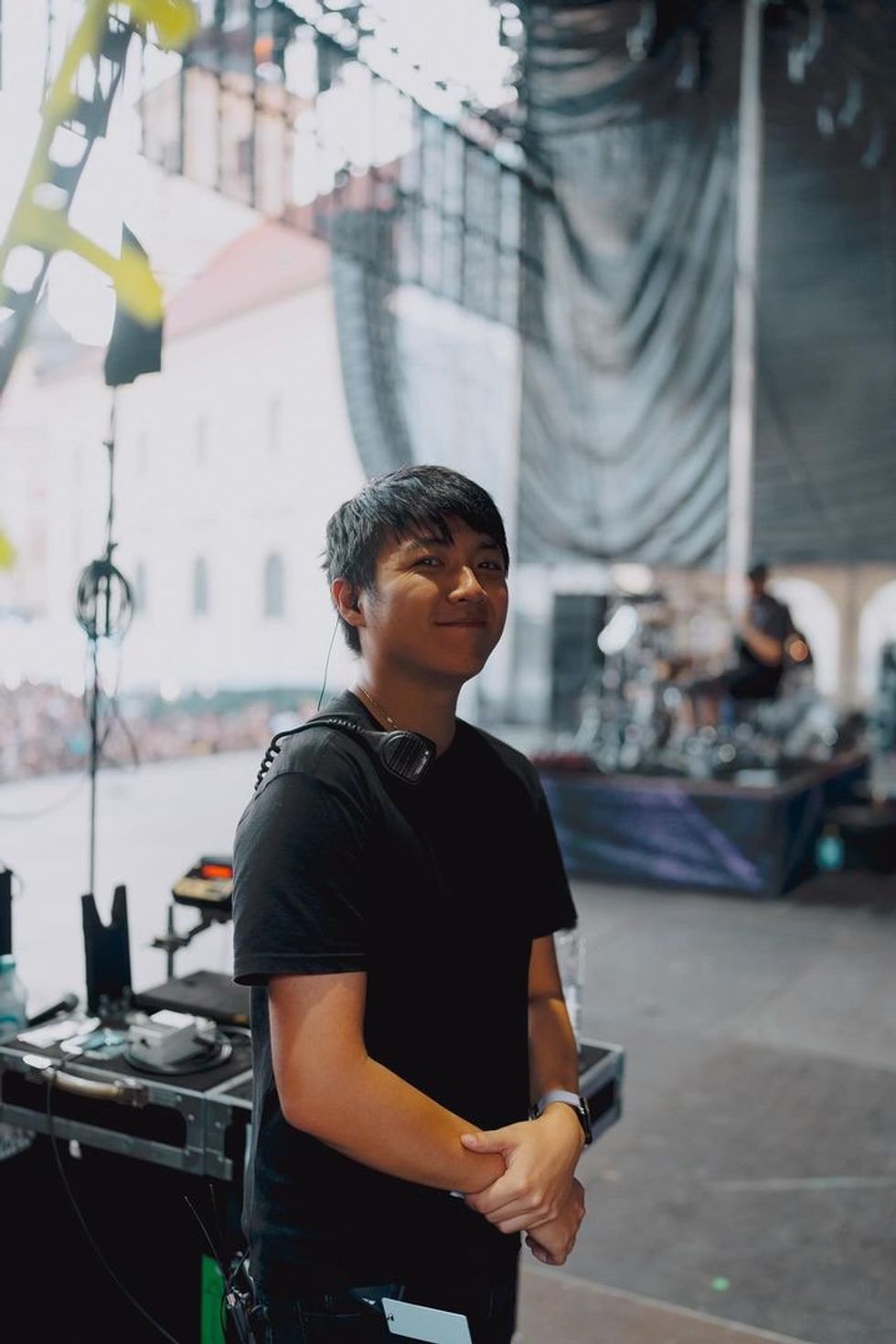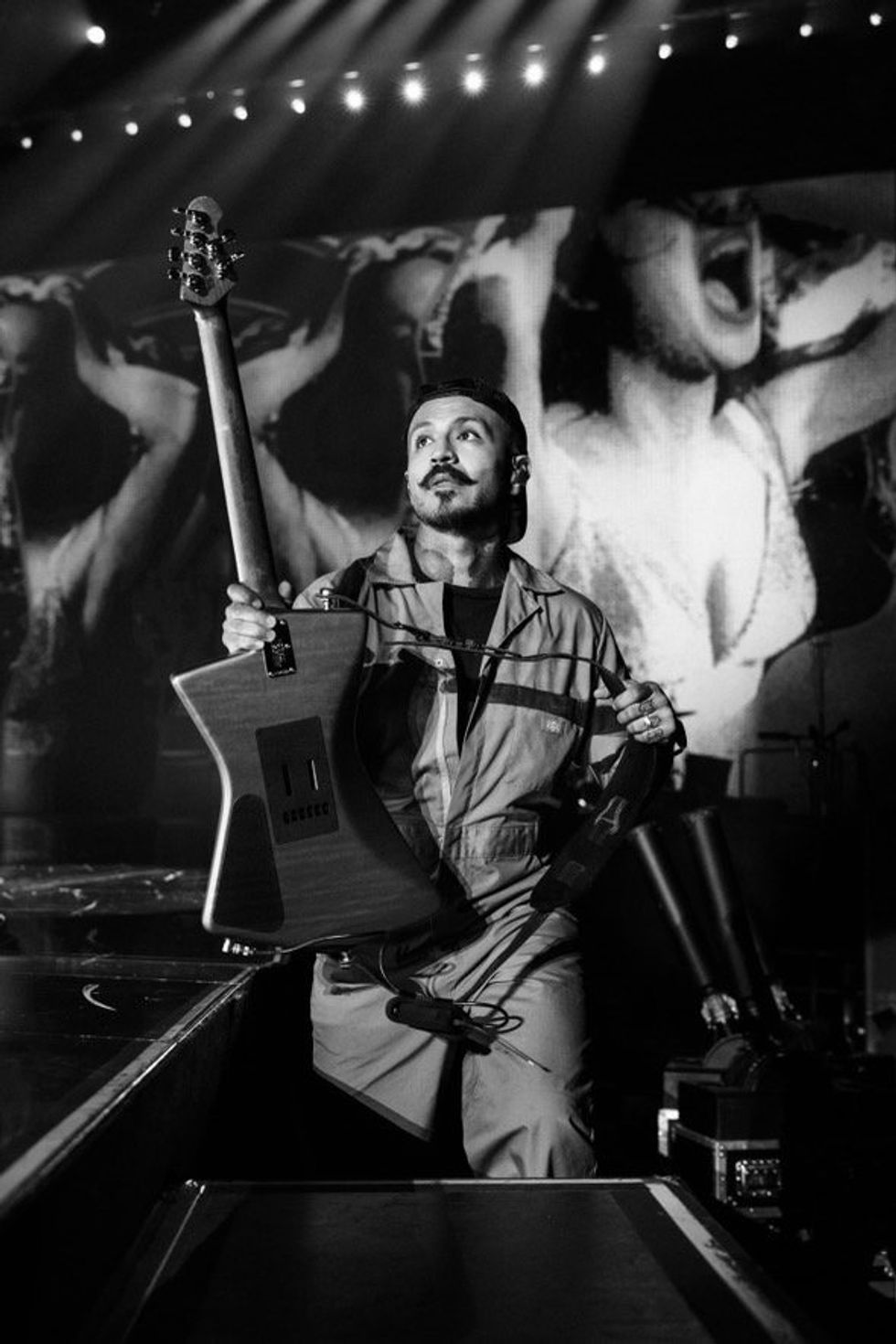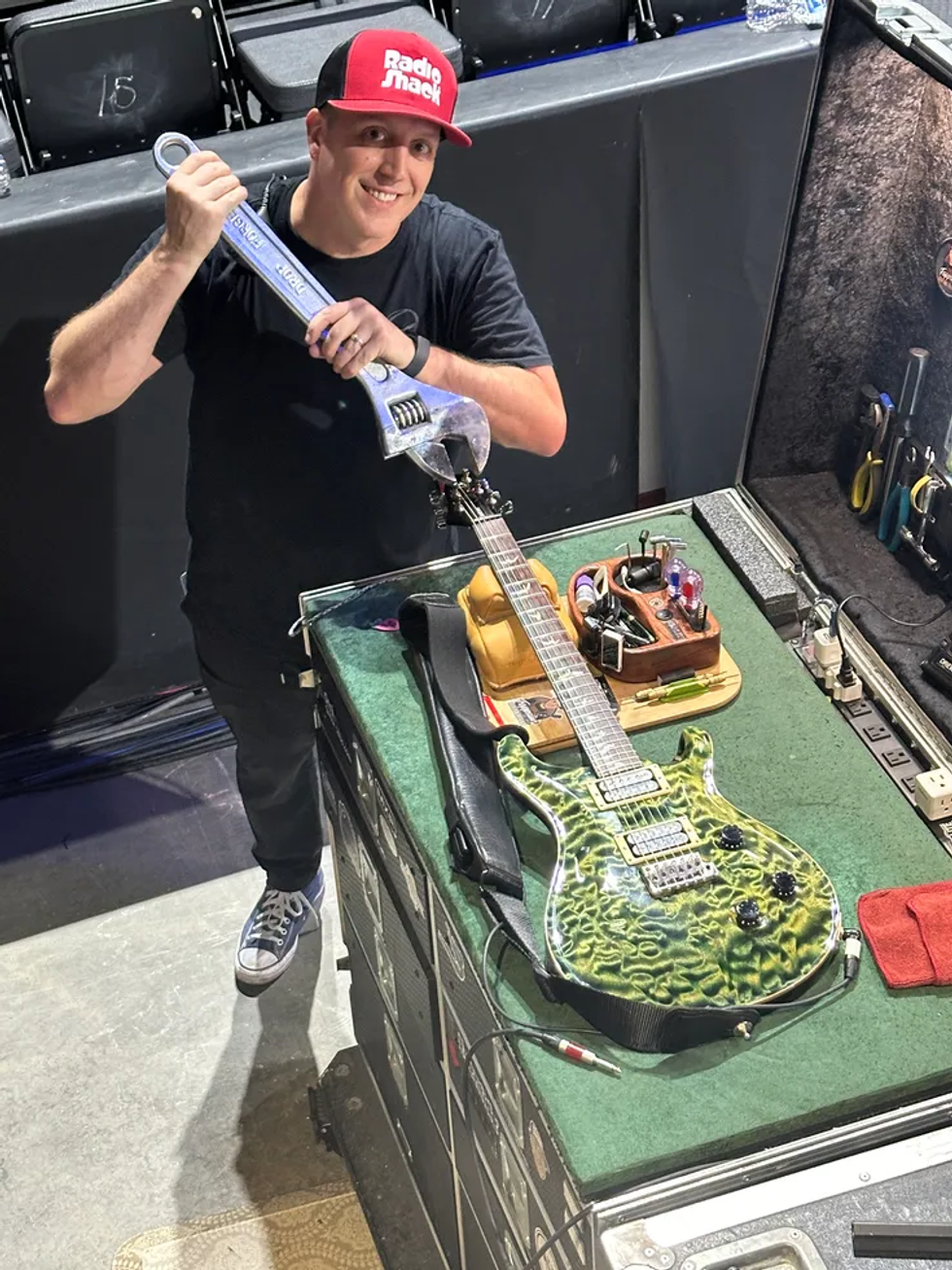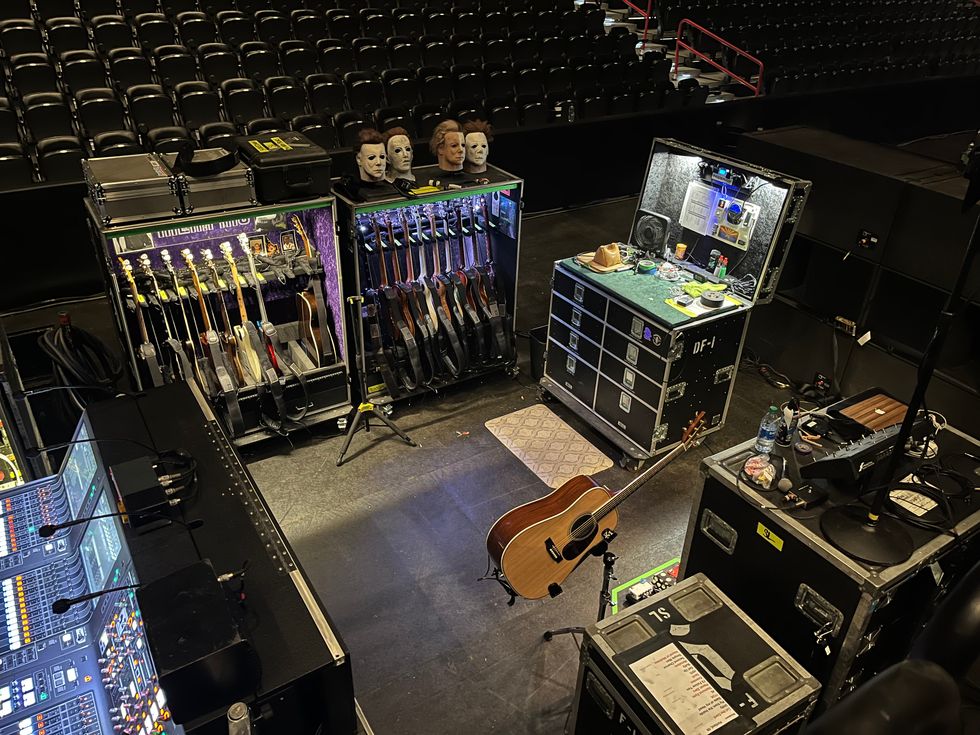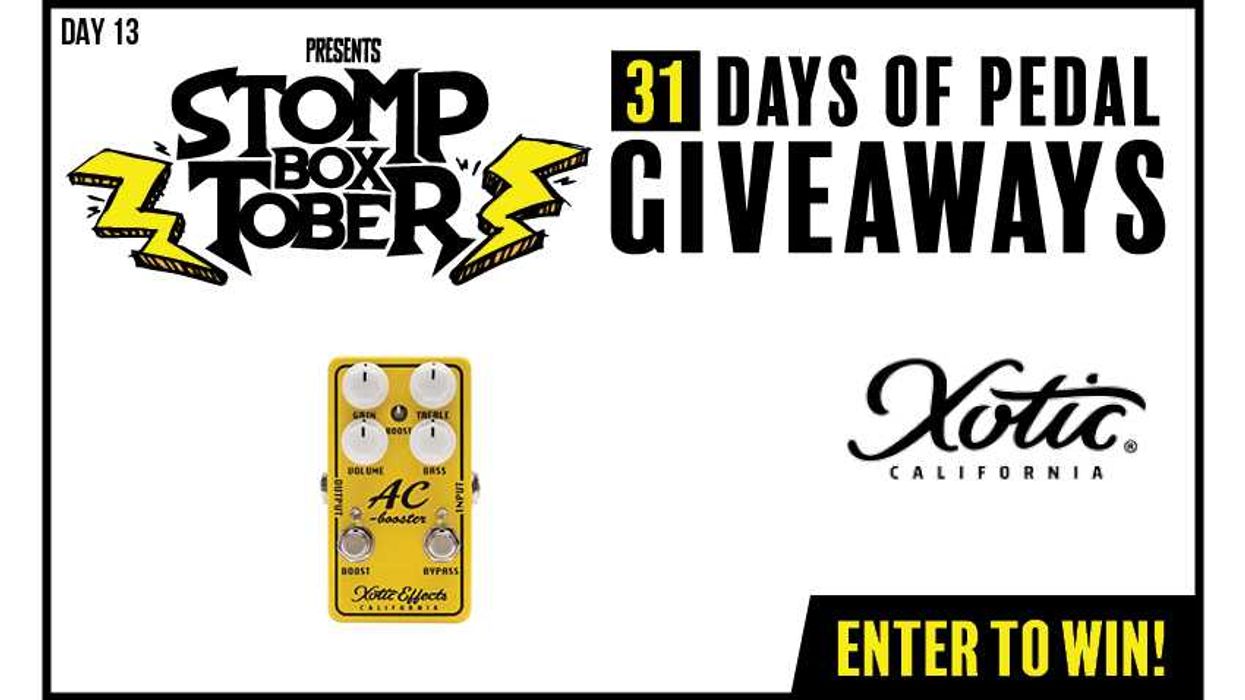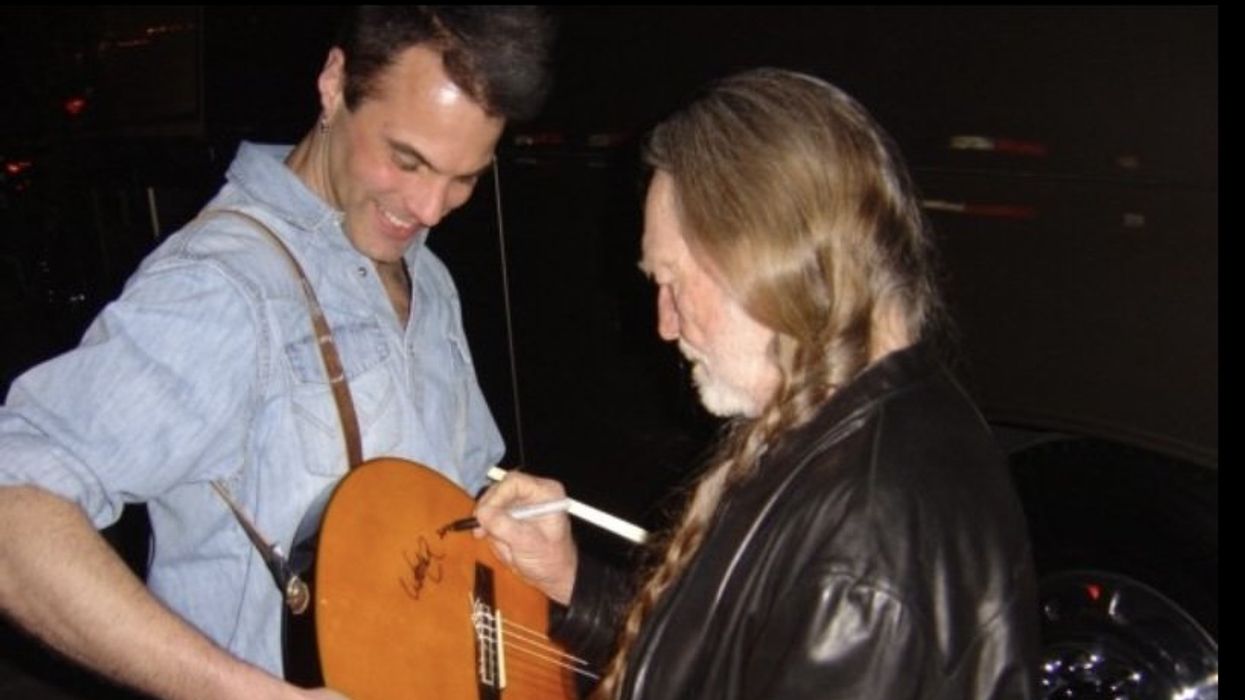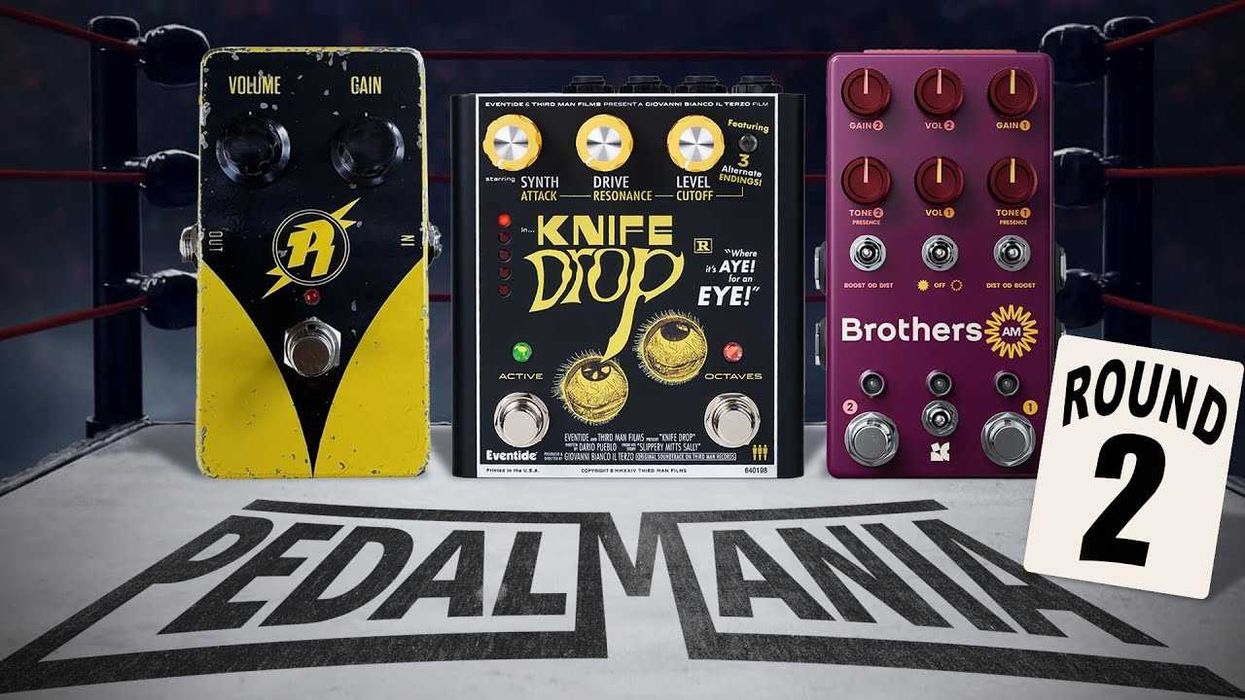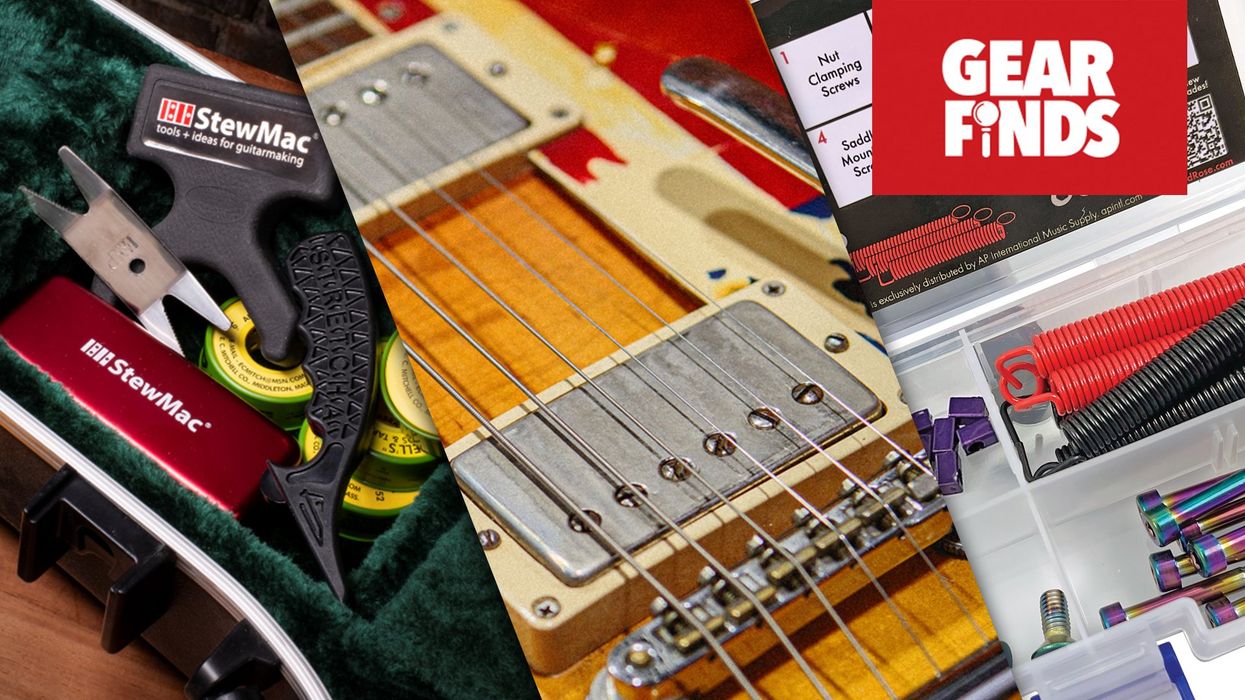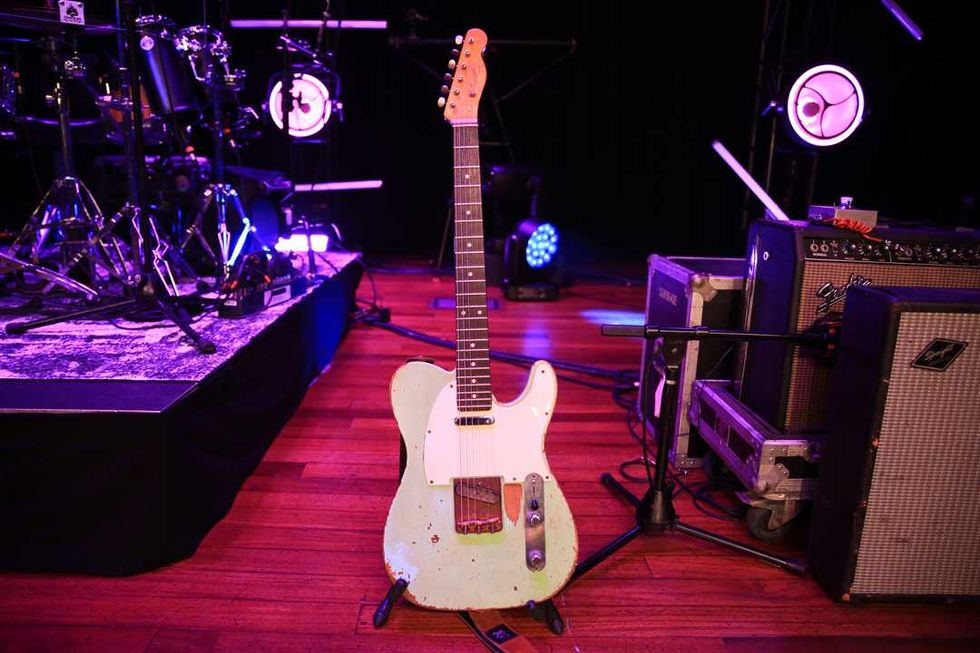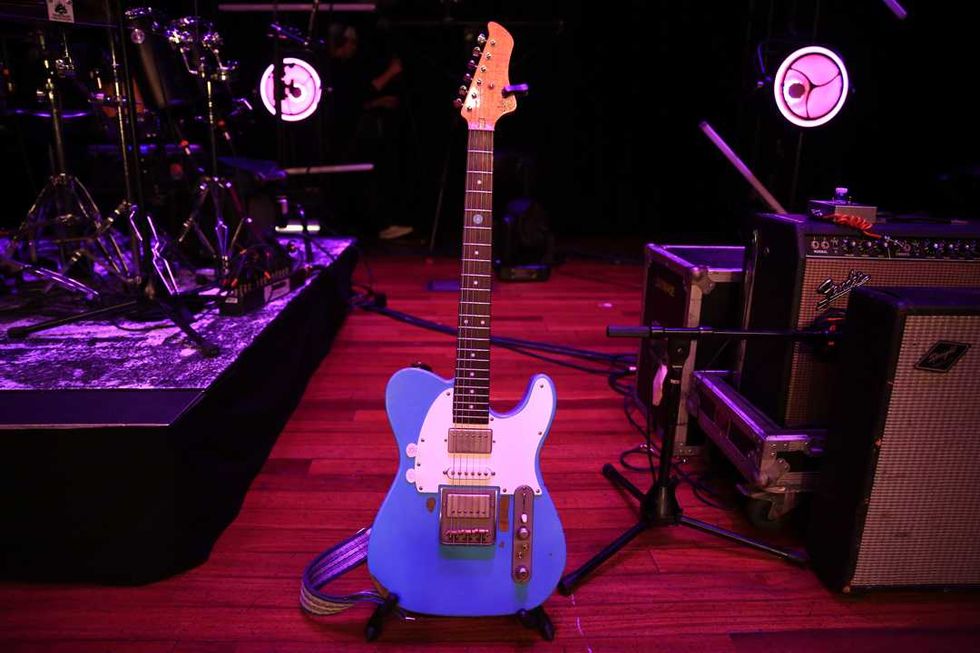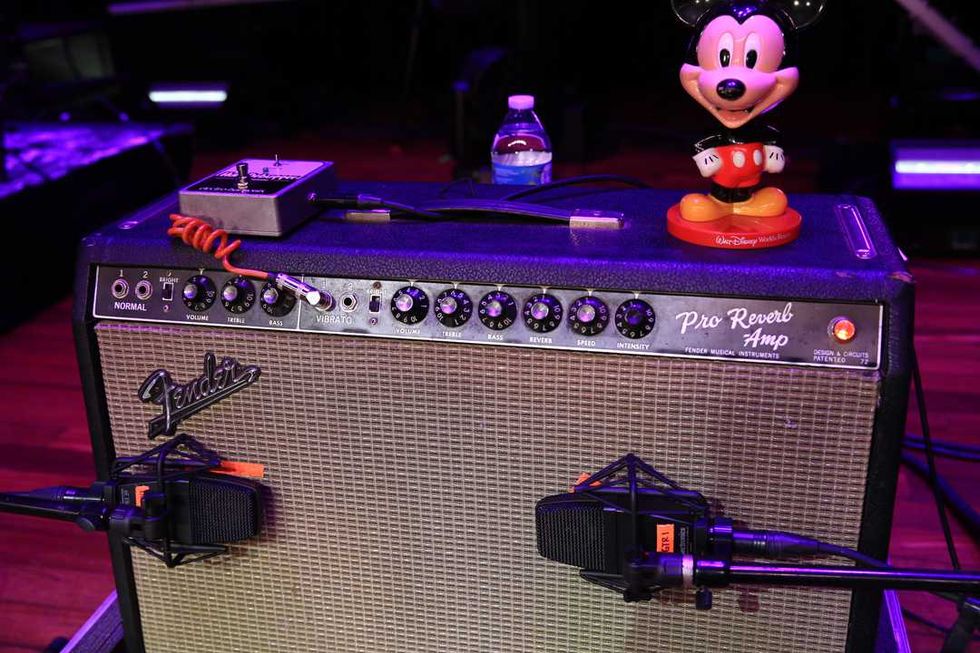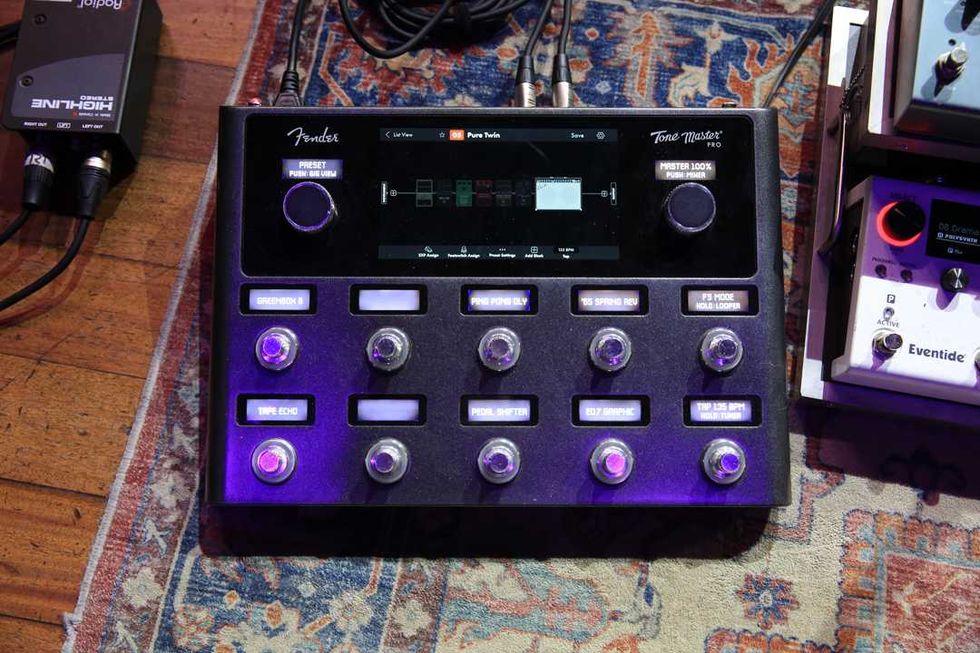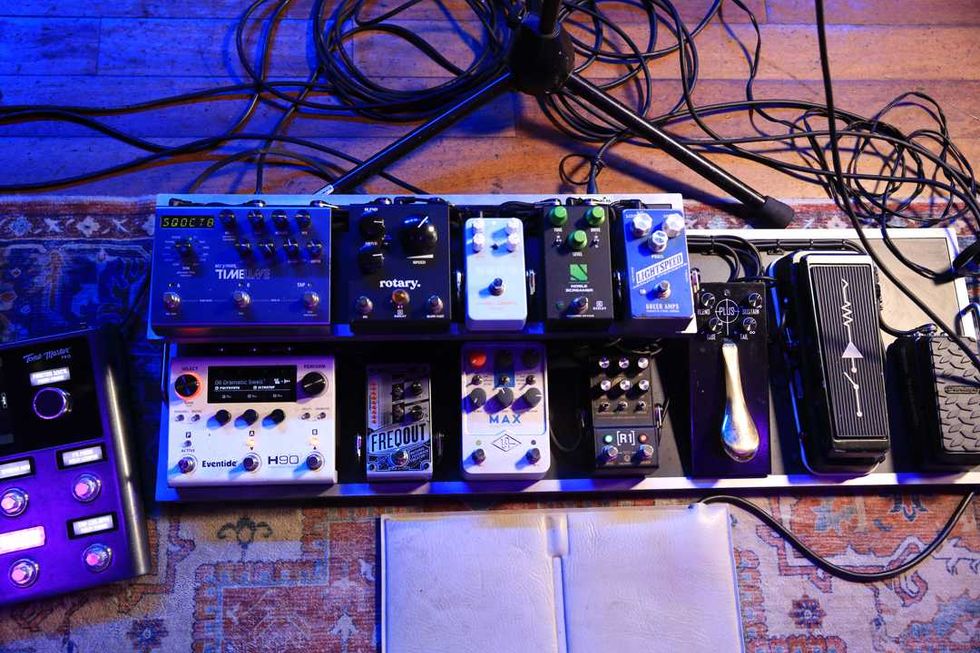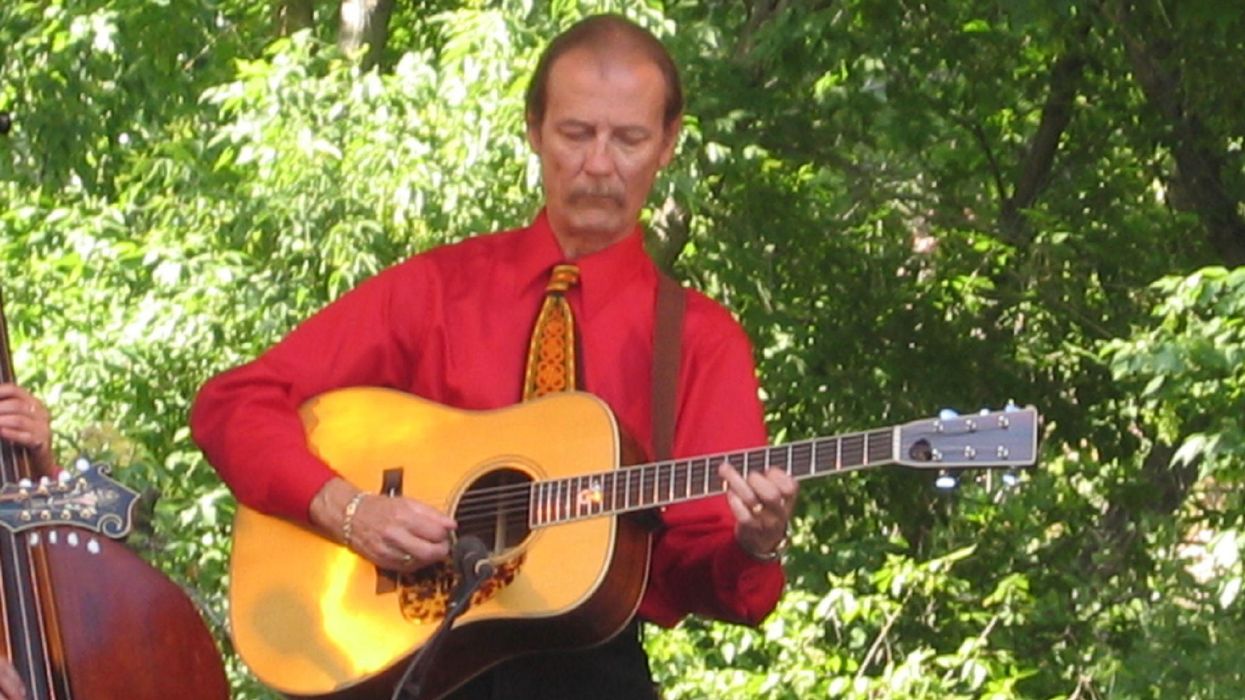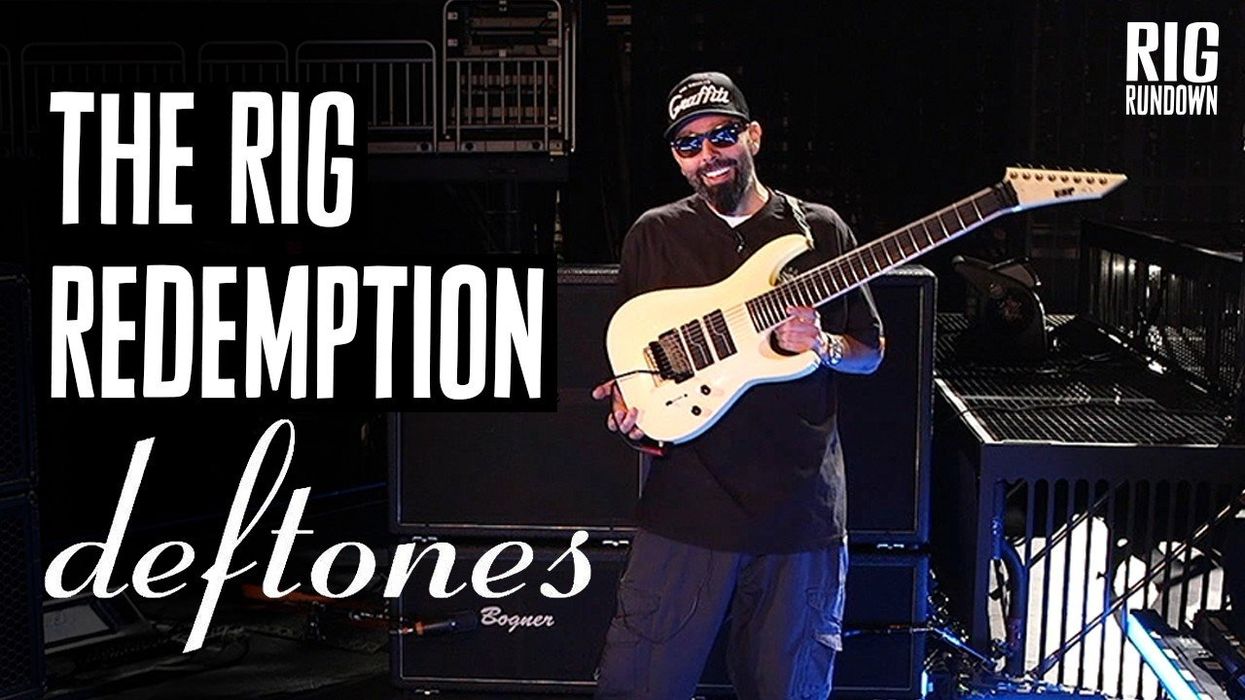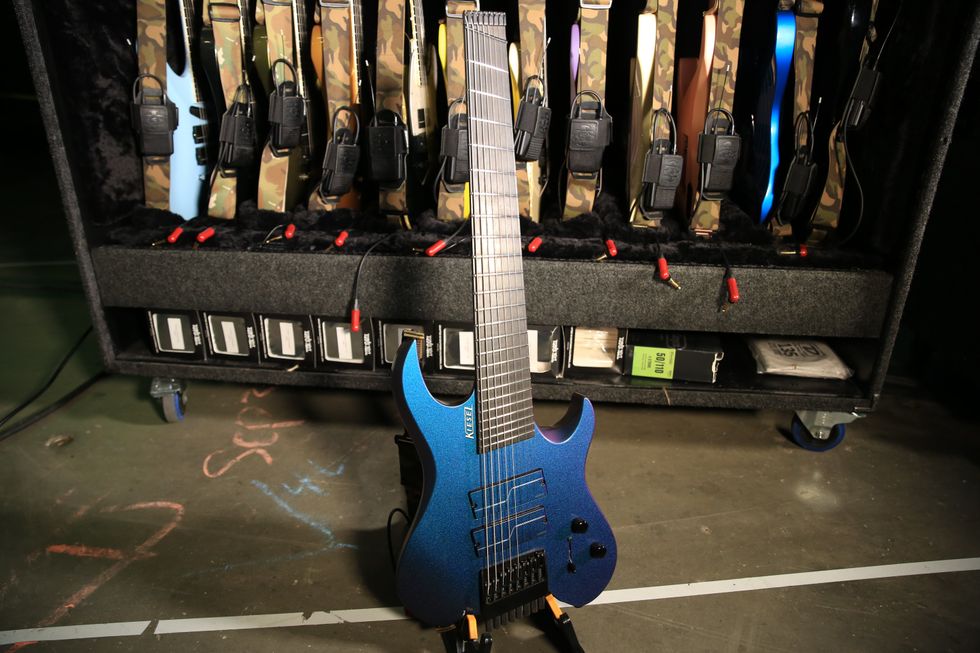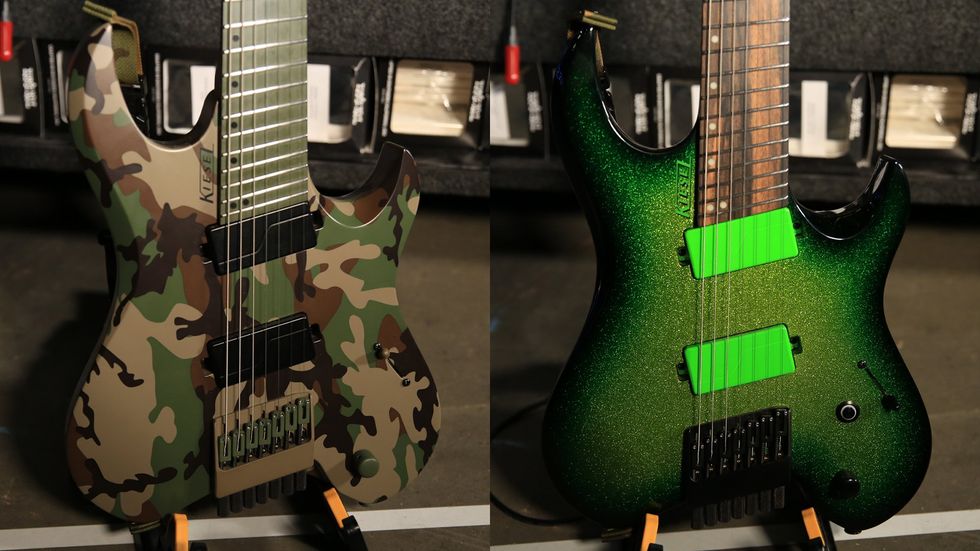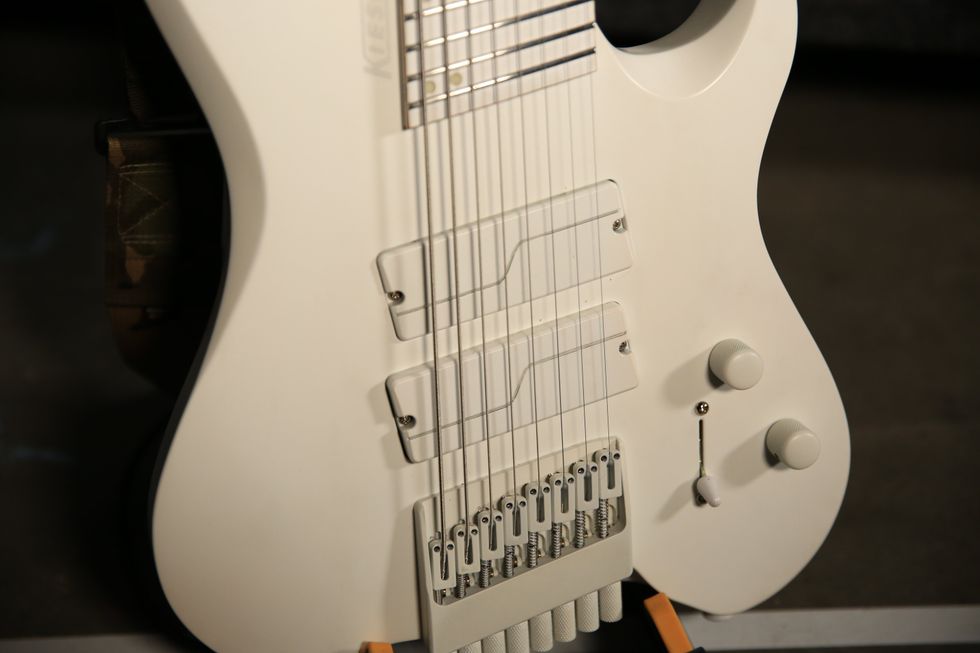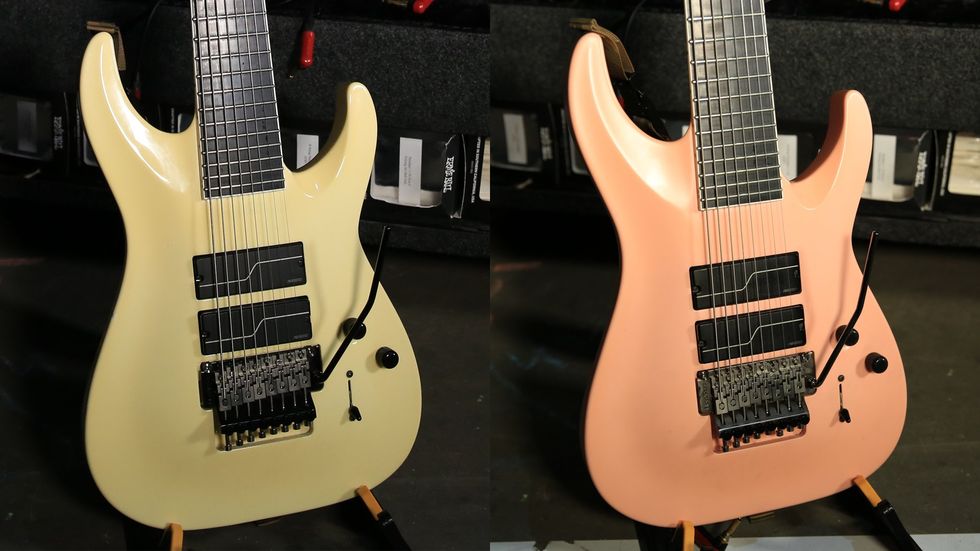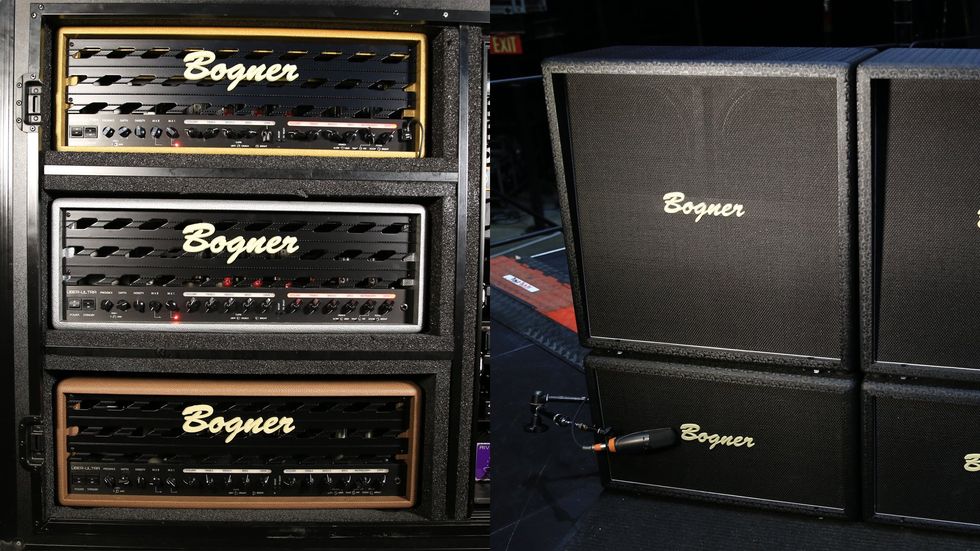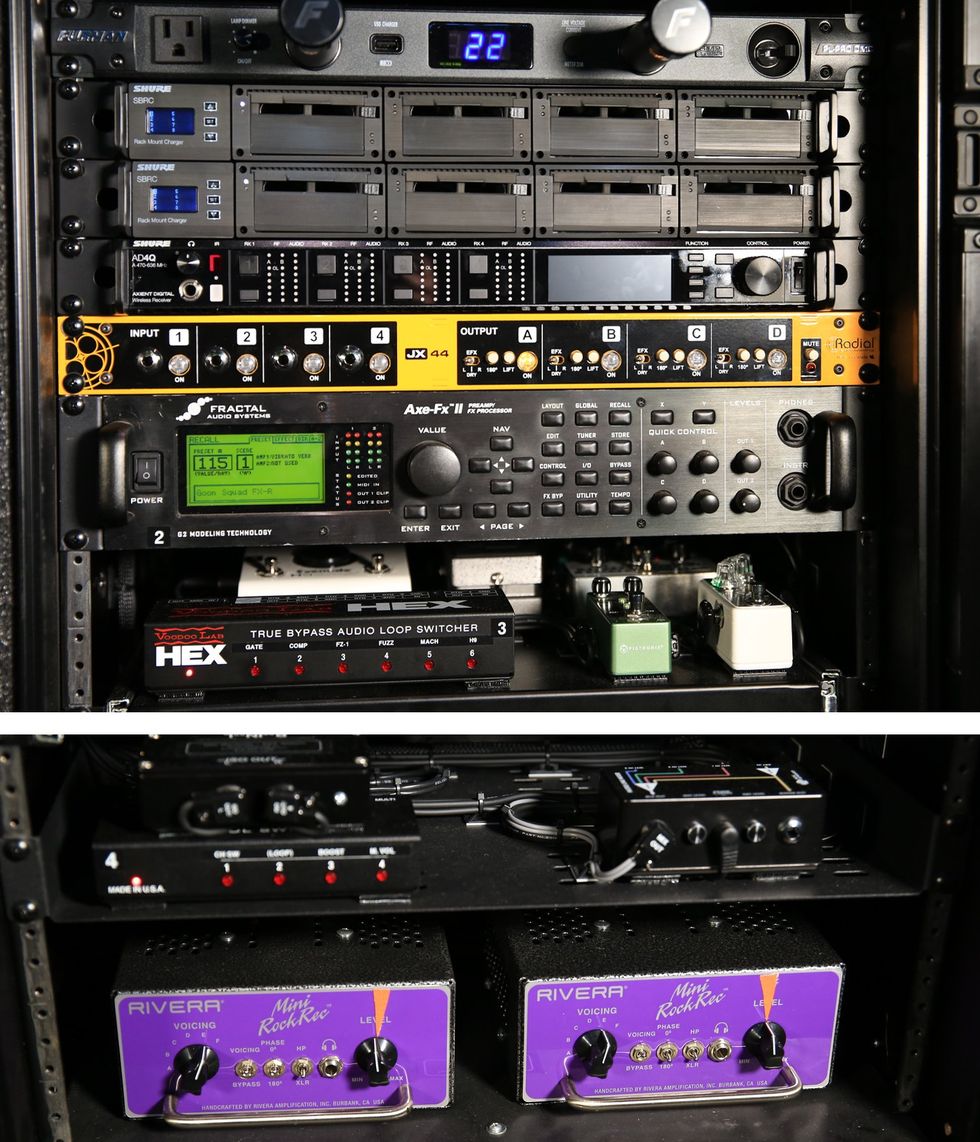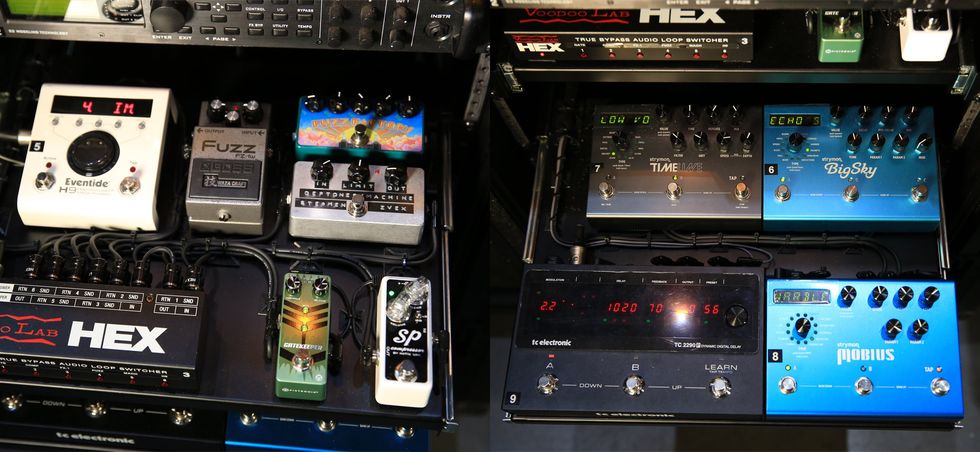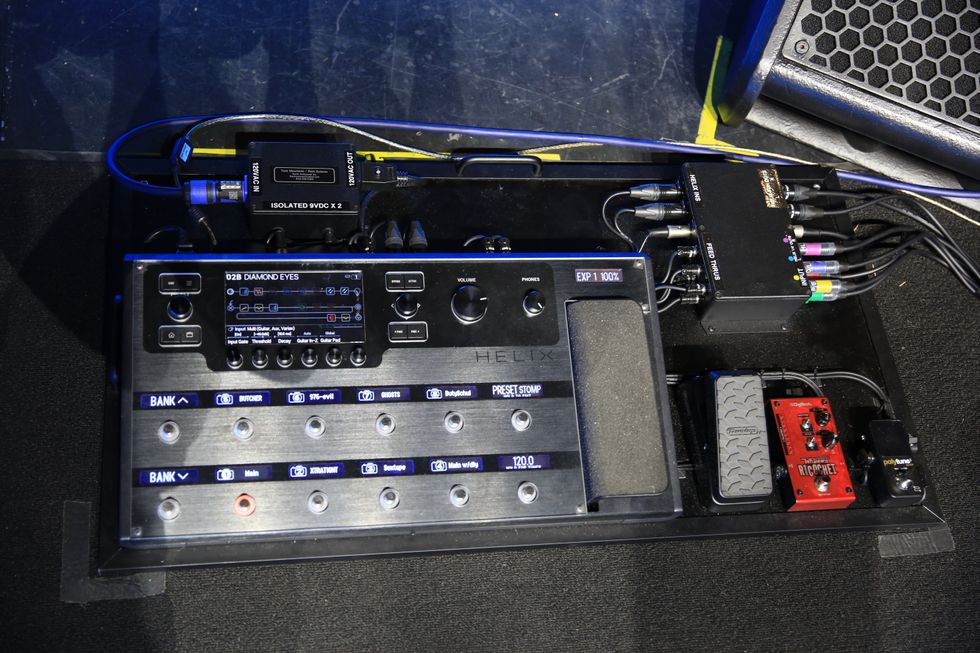Photo by Rosa Paolicelli
Though some may not subscribe to the frequently heavy and political lyrical themes in her songs—she’s an avid commentator on political ironies/hypocrisies and issues ranging from racism to poverty and sexual equality—few could fault her stalwart refusal to let any corporation dictate what, when, where, why, how, and with whom she records. And no matter what you think of DiFranco’s worldviews, only the crustiest of curmudgeons could slight her instrumental verve and inventiveness. Though she mostly plays acoustic and insists, “I don’t really have what it takes to get off on hard rock or amped-up music,” her driving acoustic work is mind-bogglingly intricate—especially for someone who also handles vocal duties. Famous for its alternate-tuning adventurousness and a percussive attack that’s influenced as much by funk bass playing as it is folk, world music, and jazz, DiFranco’s playing is rife with hammer-ons, pull-offs, snaps, and pops—all amplified through a multi-signal rig that includes pro-audio outboard gear, a wah pedal, a Rivera combo, and, more recently, a ’60s Magnatone Twilighter tube amp that her husband and producer, Mike Napolitano, got her hooked on.
We recently spoke to DiFranco about her inner guitar nerd and how playing at protest legend Pete Seeger’s 90th birthday in 2009 impacted her upcoming release, ¿Which Side Are You On? (in stores January 17)—the first album she truly feels is an accurate reflection of who she is as a guitarist and songwriter.
You’re a hero to a lot of musicians and everyday people because of your courage to stand up not only for yourself but also for big causes—you’re kind of a thorn in the side of The Man, really. But we thought it’d be fun to mostly set aside that stuff and talk to Ani DiFranco the guitar nerd. How is your inner guitar nerd these days?
[Laughs.] Pretty good, pretty good. I have some new guitars in my stable these days. I have a new baritone that I’m playing onstage. I’m not touring with the other new instruments I’ve got—but I’ve been recording with them. I’ve been playing Alvarez guitars pretty much my whole career, and they’ve served me really well. The company has been a great friend to me and has designed guitars for me along the way, including this new baritone that I’ve been playing and really loving—and I think a lot of my stage sound is very related to those instruments and their strengths. I evolved my stage sound very much in relation to the Alvarez guitars that I’ve been playing. But more recently it’s been very exciting, because I’ve gotten into other instruments, too. I got an old Martin D-28 and an old Gibson.
Is that the dark-sunburst archtop you’ve been playing in some videos that are online?
No, that’s a tenor guitar. I have several 4-string Gibson tenors from the ’60s that I play onstage, and on “Zoo” and “¿Which Side Are You On?” from the new album.
Which songs did you use the Martin D-28 on?
I used that on “Mariachi” and “Unworry.” I also got a little handmade parlor guitar—it’s got no discernible manufacturer, and we’re not sure how old it is. It’s simply got a name carved in the face of it: “Ted.” So I call it Ted [laughs]. It’s just this little, beat-up thing that my husband found for me years ago when we were first dating. It needed a lot of work, and finally a few years back we brought it to a luthier and got it up and running. It’s just a beautiful sound. When I play it, I suddenly feel Brazilian or something—there’s just something rich and organic about it. It takes a lighter touch, though. Onstage, I tend to beat guitars to a pulp, but in the studio I take the opportunity to be more subtle.
“Ani’s new baritone guitar is a custom Alvarez made after several consultations between her, myself, and Chrys Johnson, who was an artist rep for Alvarez at the time. It has their System 600 preamp and has all solid woods—a cedar top, mahogany back and sides, and an ebony fretboard. It has a Masterworks [Alvarez’s top-of-the-line series] mini jumbo body, and is 25.5" scale but is set up as a baritone. Its voice is superior to any of the other baritones she has—it’s very rich and requires very little EQ onstage.”
I’d been searching for an acoustic baritone that I could play onstage to get a huge, warm sound without feedback. And not only big and warm on the bottom, but y’know, magnetic pickups are not the loveliest, so it’s also an absence of that magnetic-y, high-end sound. But the new baritone has a longer neck and a somewhat bigger body than my standard 6-strings.
What other new gear discoveries have you made?
Playing is 90 percent your fingers, but a nice amp makes a big difference from a shitty amp [laughs], and the same goes for a nice guitar and a shitty guitar—even just on the level that it’s more inspiring to work with. My husband turned me on to Magnatone Twilighter amplifiers from the ’60s. I don’t know when they stopped manufacturing these things, but onstage and in the studio I tend to mic the acoustic guitar, take a direct signal, and also put it through sometimes two amplifiers—one for crunchier distortion and one for a cleaner and often tremolo’d sound. Then I mix them all together in various amounts to get the sound that I’m looking for in each song.
What is it about the Twilighter that you’re liking so much?
It has what you would call genuine vibrato. Y’know, when you see vibrato on a guitar amp, it’s usually just volume fluctuation, but the Twilighter actually bends pitch.
Is that what’s making the rotary-speaker-type sound on “Splinter” and “Albacore”?
Yeah. In fact, you’re hearing it really on most of the guitars on most of the songs [laughs]—and then also on many other instruments. Many things got plugged into the Magnatone on this record.
What other amps did you use besides the Magnatone?
Rivera gave me an amp many years ago, and I’ve been playing it live and in the studio often. It breaks up really well—especially for live purposes. I really drive it hard on the front end, because I mix it in just a little bit with the direct sound. I need just a little crunchy flavor in there.
Given how you use so many different signals live and in the studio, is it hard to dial in your sound?
Onstage and in the studio, I do a lot of EQ-ing. A lot of it is taking away all the high end—because that magnetic-pickup high end isn’t a nice sound. So, pretty much above 6 kHz, I start sloping my guitars quite radically. On the bottom end, I push 63 Hz, 80 Hz, and 100 Hz, if I can get away with it. That’s where I like my guitars to live, because that’s what I think of when I think of an acoustic guitar sound, whereas some people do the opposite.
Do you use acoustic EQ-ing gear or pro-audio outboard gear?
Outboard gear, yeah. I have a graphic EQ inserted on each guitar. So I travel with a monitor rig that includes a case that’s all graphic EQs. I rotate six guitars onstage, and each of them has their own multiband EQ.
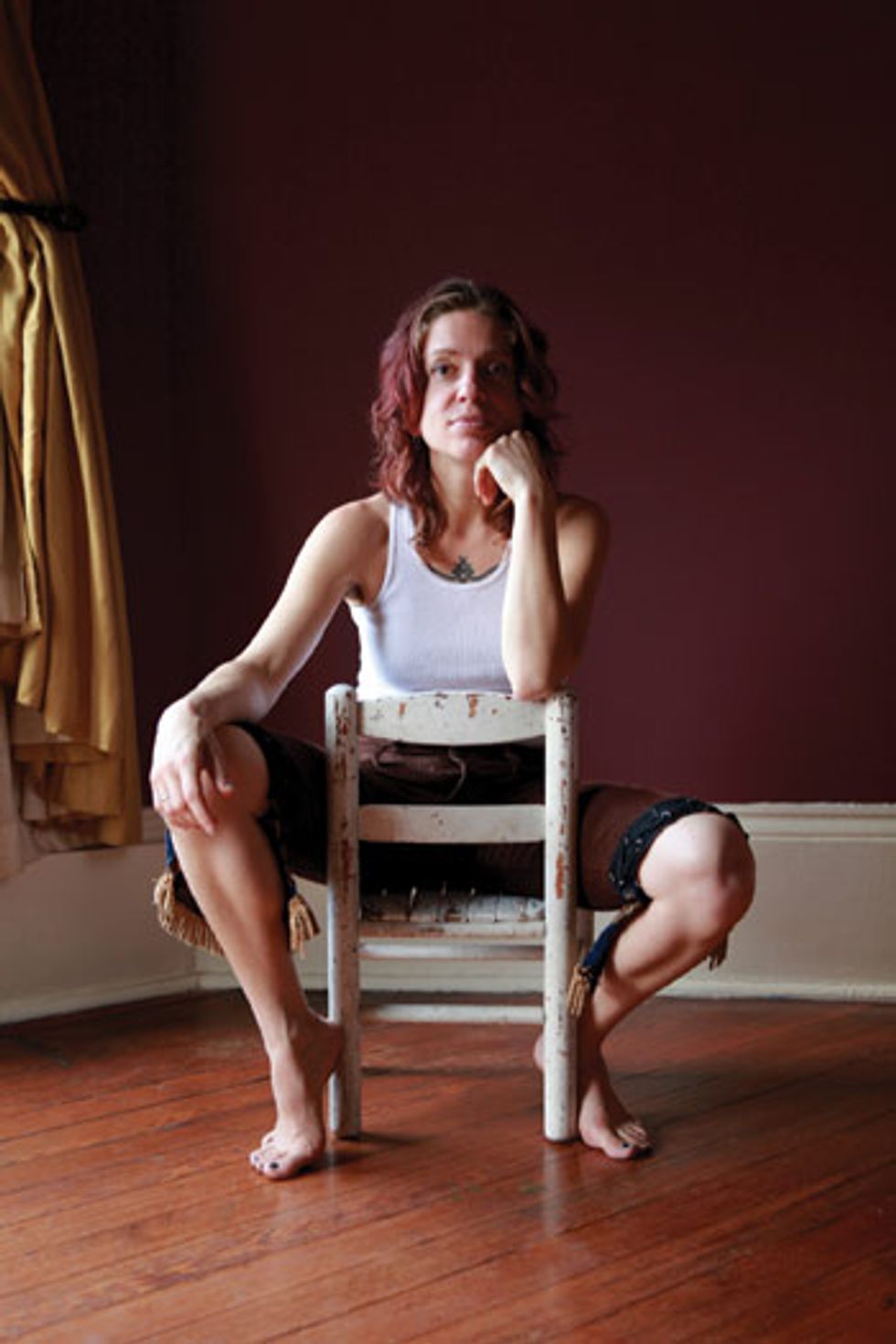
Photo: Patti Perret
No. For a bunch of years now, I’ve been doing the same thing, which is using really thick fake nails. There’s one brand called Nailene that’s ridiculously thick—so thick that I don’t see how any woman would use them as fashion nails. They’re twice or three times the thickness of a regular human nail, so they’re just these wedges of plastic that you super-glue on. I also use electrical tape down to my second knuckle to give added reinforcement to the nail. If it pops off, live, at least it won’t go flying and I can glue it real quick between songs—we have this super-fast-setting super glue—and the tape also protects my skin.
What kind of glue do you use?
It varies. I’ll use the Nailene glue or just straight-up super glue or whatever’s available.
Let’s move on to playing and songwriting. What’s the biggest mistake made by guitar junkies who’re also singer-songwriters?
I started out very much as a songwriter with stuff I wanted to say, and the guitar was the vehicle to say it with, as opposed to the other way around. So I became a guitar player second. But there are many ways to skin a cat. For any artist—and any person, really—it’s more about knowing yourself and accepting your strengths and weaknesses and working with them instead of trying to work against them or trying to be something you’re not.
Even though you started out as a songwriter, you pursued more esoteric guitar directions than most singer-songwriters do: You play nonstandard tunings and use a lot of hammer-ons and tapping techniques. Why do you think that is?
Well, freedom was a big factor for me in a lot of ways—and one of the ways is just freedom from knowledge [laughs]. Y’know, ignorance is liberating. I took some guitar lessons when I was very young, and that gave me a pretty cool basis, I think, but I didn’t take it very far. So most of the way that I play just comes from my own sense of invention and expression. I think if I’d known a few more of the rules along the way, then maybe I would’ve been caught between whether to follow them or not. Somebody showed me DADGAD when I was a young girl, but that was sort of the one tiny little introduction I had to open tunings, and from there I just invented them all by myself. When you spend so much time with an instrument, the curiosity of turning the pegs is inescapable. It was like, “If this is your palette of colors, what kinds of shapes does your hand make and what kinds of voicings and chord flavors naturally happen?” Open tunings were just something I pursued out of my own creative drive. And the sort of percussive attack with which I play just came out of years of playing in bars and being my own rhythm section.
What excited you most about recording your new album, ¿Which Side Are You On?
I guess taking my time, which is a new thing for me. I mean, I’ve made 20-some records—and most of them very quickly. I’ve been in a big hurry my whole life—it was always, “Get it out there, and keep going, and make a new record, and change, and reinvent yourself ….” That’s just sort of my personality—to plow forth. About five years ago, I had a baby, and that—and, I guess, just getting older in general—changed the whole pace of my life. I don’t move at quite the clip that I used to. So this new record I spent over two years working on, and I think it shows. In the past, I’ve been too willing to just hit record and move on. Now I make a recording and then, six months or a year later, I might say, “That’s too slow” or too this or too that. My husband is very helpful for me in that area, because he doesn’t settle. A lot of what I do these days is, I’ll take my usual guitar and plug it into my usual amps and stand there and go, “Okay, I’m ready.” But he’ll say, “Mmm, yeah, that’s not the best sound.” He slows me down and helps me pursue better sounds, better performances, and better production. So it’s been really cool at this point in my life to have hit a whole new stride in the studio, where I’m making better representations of my songs for posterity. Which makes me feel good, because I’ve always loved my songs along the way—they’ve always been this incredibly powerful presence in my life that has connected me to so many people—but I’ve always hated my recordings, because they were always haphazard and not enough of them were successful representations. So I feel like I’m upping my average of successful recordings, and that feels good.
It sounds like you used standard tuning quite a bit more this time around?
Yeah, that’s been happening. The economic recession is affecting all of us in our own way, so I’ve been doing a lot of downscaling with my touring operation. I’ve been travelling solo for the last year, actually, with a crew of four people—whereas at one point I might’ve had 12 people. So that makes me instinctually want to be self-sufficient, in case I have to be. Maybe someday I’m going to be touring alone again, or with one person, or no guitar tech. So the tactical side of my nature that has guided me through my whole career has been steering me back toward standard tuning, just in case I’m also my own guitar tech again someday. I had a little exercise last year. I got a local gig at this bar in New Orleans, where I live, every couple of weeks for a few months. It was something I hadn’t done in a long time, and it got me back to basics. It was just me and my husband showing up for the gig. I was huffing my stuff in, doing shows with three guitars. I was tuning my guitars and setting my stuff up—just to prove to myself that I can still do it. So my drifting back toward standard tuning is all about self-sufficiency—or making sure that’s possible again, at least.
Do you miss playing in all the altered tunings?
Yeah, I love altered tunings. But they really do set you up for failure onstage. You’ve got to be good at tuning, and you’ve got to be quick if you want to do it without a guitar tech. And being able to talk and tune at the same time is helpful—that’s more difficult than it should be, because I have lots of tunings. I’ll discover a tuning I like, and then I’ll write a handful of songs either in that tuning or in that tuning family—with slight variations on this string or that string—so it’s hard to even remember what the hell they are, especially when you’re alone onstage and confronted with an audience. So it’s a bit of a brain twister that I’m sure people without guitar techs could do without.
Have you had to drastically modify your set list around that, or have you tried to adapt some of your songs to standard tuning?
Well, the set list evolves organically. I always want to play the new stuff, because that’s where my heart and spleen are these days, and then I sprinkle in the old stuff—which could be two years old or 20 years old. At this point, I’ve been writing since I was 19, and I’m 41. So I know that if I just generate more songs in standard tuning, then the set list will be steered in that direction, and then it’ll be less wrenching the guitars around all night long. But when I play live with my guitar tech these days, I’m still all over the place.
Tell me about having Pete Seeger in the studio for “¿Which Side Are You On?”
That was a song I learned to play for his 90th birthday celebration, which was this big party/benefit at Madison Square Garden a few years back. So I got the job of playing “¿Which Side Are You On?” with Bruce Cockburn, and “There’s a Hole in the Bucket” with Kris Kristofferson. On [the new version of] “¿Which Side,” I couldn’t help but update the verses a little—or a lot, as it were, because that’s the folk process, and I’m a folk singer. Ever since that event, I’ve been including that song in my shows. Since I essentially rewrote the song, it’s become sort of my standard rabble-rousing show closer of late. Over the years of making this record, it just kind of sifted its way to the top and became the title because it evolved into a very political record. It’s a very poignant political time that we’re living in, and that’s just the direction this record went in. Having Pete join me on the recording was kind of a full-circle experience for my relationship with this song.
How did you approach him about it?
I called him up and said, “Pete, I’m recording this song that you recorded, y’know, back in 1953. Would you please join me on it?” He immediately says, “Hang on,” and he puts the phone down and jumps up and goes and grabs his banjo. He comes back to the phone and he’s so full of energy and passion, and he’s like, “So are you doing the this version or that version … ” and he’s sending me various versions of the lyrics and this and that, and really getting involved as only Pete will do. Anyway, we ended up rendezvousing in Hudson, New York, at the Beacon Sloop Club there on the Hudson River, which is sort of the gathering place of the Clearwater [environmental advocacy] organization. We rode up one afternoon with some remote recording gear, and he rode up alone in his car—he’s 91 or 92 at this point. He drives up, pulls his banjo out of the back—“No, thank you, don’t need help carrying it—no one touches my banjo!”—strolls on in, and, basically, in about two takes, recorded the intro to the song. It’s pretty similar to his 1953 recording. We got him playing and singing all the way through, and we had about five or 10 minutes to do this session before an unannounced children’s singing group that does progressive folk songs comes in to do their rehearsals. So, next thing you know, that’s happening and Pete is joining in with them and leading them. We ended up recording all the kids on the chorus, as well, and then we were out of there.
Session Guitarist Adam Levy on Tracking ¿Which Side Are You On?
“I first played with Ani in 2009 at Town Hall in New York City. We’d met before through mutual friends, but never jammed together. My pal Gaby Moreno—who was opening for Ani then—asked me to play with her that night. Hanging out backstage after Gaby’s soundcheck, Ani asked if I’d sit in on ‘¿Which Side Are You On?’ She didn’t say exactly what she wanted me to do, but she has a way of instilling a sense of trust—as if to say, ‘I know you’re going to kick ass, and I am, too. Here we go!’
“A few months later, Ani asked me to play on her ¿Which Side Are You On? sessions—and I was thrilled. She sent me several demos so I could learn the songs. Again, she didn’t tell me exactly what she wanted. I figured we’d sort it out when I to got to New Orleans with my Gibson ES-335, and we did. I’d tune into her vocal and react to that, or her guitar part. Sometimes I’d try to weave in between. The things I played and the tones I got—it was all spontaneous and raw, someplace between jazz and rock ’n’ roll.”
Adam is such a great player, and he’s a friend of many friends of mine in New York, so I’ve known him for years. I think it was about two years ago that I was playing at Town Hall in New York, and he was in town so I invited him down to sit in for a few songs. He sat in on “¿Which Side Are You On?” and another song, and he just slayed it, so I just had the idea that it’d be nice to have an electric guitar and a different approach to play off of my type of guitar playing. So I invited him down to my home studio in New Orleans for two days, and we just pulled up basically everything on the record and had him have a go at the whole record to see what stuck.
Did you give him artistic free rein or did you give him some direction?
If I’d had my druthers, I would’ve just hit record and he would’ve just played from his spleen like we did onstage. But in the studio, he was looking to me for more direction. My instinct, especially as I get older, is that I prefer to work with talented, mature musicians, and tell them next to nothing. Tell them as little as I can, and just try to have everybody bring their full selves to the table. Because, often, if I’m trying to make somebody play what I hear, there’s a compromise that happens, rather than somebody’s full vision be at evidence. I try to tell Adam and everyone on the record as little as possible.
Speaking of electric, you played electric on “If YR Not,” but you don’t play it much. Why?
It’s just a very different beast—especially the way I have my acoustic guitars set up. All the guitar players I know, when they come to my house and pick up my acoustics, they’re, like, “Arg! What the hell—I can’t play this!” I have the highest action ever.
Because you play really hard?
Yeah. I detune the strings a lot with these open tunings, and then I just play really hard. So, with a normal level of action, you get a lot of buzzing and you can’t play as aggressively as I do. So an electric guitar takes a much lighter touch, and that’s just sort of the antithesis of the way I play. Over the years of playing and going deeper into that sort of high-action, very aggressive, pulling-and-snapping acoustic technique, I just get further and further from being able to even tolerate an electric guitar.
Do you remember which electric you played on that song [“If YR Not”]?
It was one of our old [hollowbody] Gibsons, but I can’t remember the exact model. That one was tricky to record. Mike, my husband, was at the helm, and again and again, he’d say, “Mmmm…that’s not a cool enough sound.” Originally, I tracked it with my acoustic running through amps, and he’s like, “Meh ….” Eventually, we arrived at the take that’s on the recording, and that seemed to satisfy him in terms of cool guitar tones. I think what I used was a tape amp—like, a little reel-to-reel tape recorder that he uses to get a really badass distorted sound. I don’t even understand it … it’s like, you go into this tape recorder and come back out of it, and it amplifies your guitar sound …
That’s supposedly how the Stones got that cool acoustic sound on “Street Fighting Man” …
That’s right. Mike has had one of those things around for a while, and he pulls it out when he needs that badass crunch from the bad old days.
What album might fans of yours be surprised to know you own?
I don’t know if it would surprise anybody, but when I listen to music at home, it’s by and large jazz, world music, or super hardcore folk and roots music—oh, and funk. There’s so much great music in New Orleans, and I’m in love with it all. I generally don’t get into pop music, and I guess I don’t really have what it takes to get off on hard rock or amped-up music. I’m more chill, I guess.
Looking ahead, is there any area in which you’d really like to improve as a musician?
Yeah. X is singing, and Y is guitar [laughs]. I mean, I would love to get better at a lot of things. I would love to really learn how to play piano, which I’ve wanted to do my whole life—and I still talk about taking lessons. But, in the meantime, the fact that I’ve done this thing—playing acoustic guitar and singing—for so many years, it’s kind of become second nature to me. And that’s something I’m so grateful for—the fact that I’ve gotten so deep with one instrument that it’s an extension of my body. And that means that I’m less lonely when I’m lonely, I’m less sad when I’m sad, because I have this tool to release all of that from my body. My relationship with my guitar—and also with my voice—is really sacred to me. I feel like it has an infinite depth to it. Like, I’ve been doing this for 20 years, and I feel like I’ve only begun to learn how to play and sing. More recently, especially after becoming a parent and having lots of shifts go on in my personal life—getting older, getting humbler—I feel like I’m evolving in my playing and singing because of that. I feel like there’s a depth that I’m able to achieve onstage these days that I wasn’t able to achieve even three or five years ago. And I sort of feel like that will probably never end. So, really, I just want to keep going down these roads and see how deep I can go.
For years, you’ve sort of been the poster girl for DIY musicians. Having done this for a while, what would you say are the most important things for indie musicians to keep in mind—and has your approach changed over the years?
Well, I think the most important thing that I would say to keep in mind is why—why do you make music? Especially in today’s world, where we’ve had so many generations of young people who’ve been steered into making money as an end in itself, or “success” being an end in itself—to sell millions of records and be rich and famous. That may or may not happen to a musician. Probably not. But still, you can have a great, lifelong career in music without that. I’m probably an example of that. Maybe I’m more rich and famous than most [musicians are likely to be], but all around me in the folk and roots world are long and fruitful careers that don’t really end up in fame but are just playing music as a job—which I think is a great, great privilege.
My music has brought me all over the world, it’s brought me incredible adventures, it’s brought me incredible friends and connections with other musicians. It’s brought me to places like Burma, on the other side of the world, where I went with a political delegation and some other musicians. We went deep into the jungle, where these people were hiding from a very violent and oppressive regime, fighting for democracy—and risking their lives to do so. They were living in these brutal conditions. They’d fled their villages and homeland. There was a lot of ethnic cleansing going on. And we go, and we’re these rich, white Americans, coming from the complete, opposite world. We show up in this place to learn and observe, and you can imagine the distance, the chasm between those people and us, which existed for many good reasons. And then we would sit down and, through a translator, we would have a conversation with the village leaders. And then their children would stand up and sing. As soon as the children started singing, the atmosphere loosened. And then we pulled out the guitar that we brought with us, and passed it around. It was me and Damien Rice, the Irish singer-songwriter, and the minute he and I started singing, we were all family. I could cry just telling you about it: There was suddenly no difference between the rich, white, privileged people and these incredibly oppressed, third-world, you-couldn’t-understand-our-suffering-if-you-tried people. The minute we made music together and we opened up our mouths and sang, that distance disappeared entirely. It was such a powerful example to me of why we play music—to connect with each other, to make family with people we don’t even know. And as long as you can continue to be inspired by that process, by the real meaning of art, then the fame and fortune will or will not work itself out. It’s insignificant compared to what you’re doing and why.
Ani DiFranco’s Gear
Guitars
Two Alvarez-Yairi WY1 Bob Weir signature acoustics with Alvarez System 500 preamps, Alvarez-Yairi DY62C with Alvarez System 600 preamp, Alvarez MSD1 short-scale dreadnought, custom Alvarez baritone, vintage Martin D-28, 1930s Gibson-made Cromwell tenor guitar with Fishman archtop pickup, vintage Epiphone Zenith tenor guitar, “Ted” parlor guitar of unknown make
Outboard Gear
Klark Teknik DN360 rackmount analog graphic EQs for each guitar (live)
Amps
1960s Magnatone Twilighter 260 2x12 combo, Rivera Sedona 15 combo
Strings
D’Addario EJ16 and EJ17 sets, D’Addario phosphor-bronze sets (.070, .056, .042, .032, .024, .016) for C-to-C-tuned baritone
YouTube It
At a 2007 gig, DiFranco rouses an enthusiastic crowd with a wah pedal and snapping and popping techniques so ferocious they’d wow Victor Wooten.
Backed by a stellar pianist and horn section, DiFranco gets infectiously funky at a 2000 House of Blues gig in Orlando, Florida.
At this April 2011 date in London, DiFranco thumps one of her new Alvarez baritone guitars through a Vox AC30 and what appears to be a Mesa/Boogie Dual Rectifier half-stack.

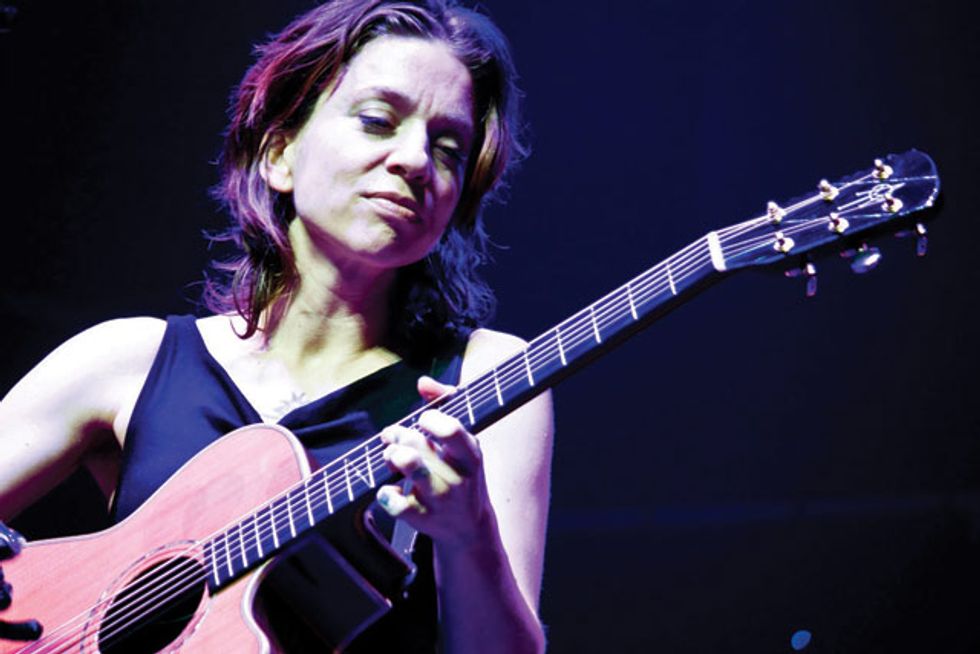
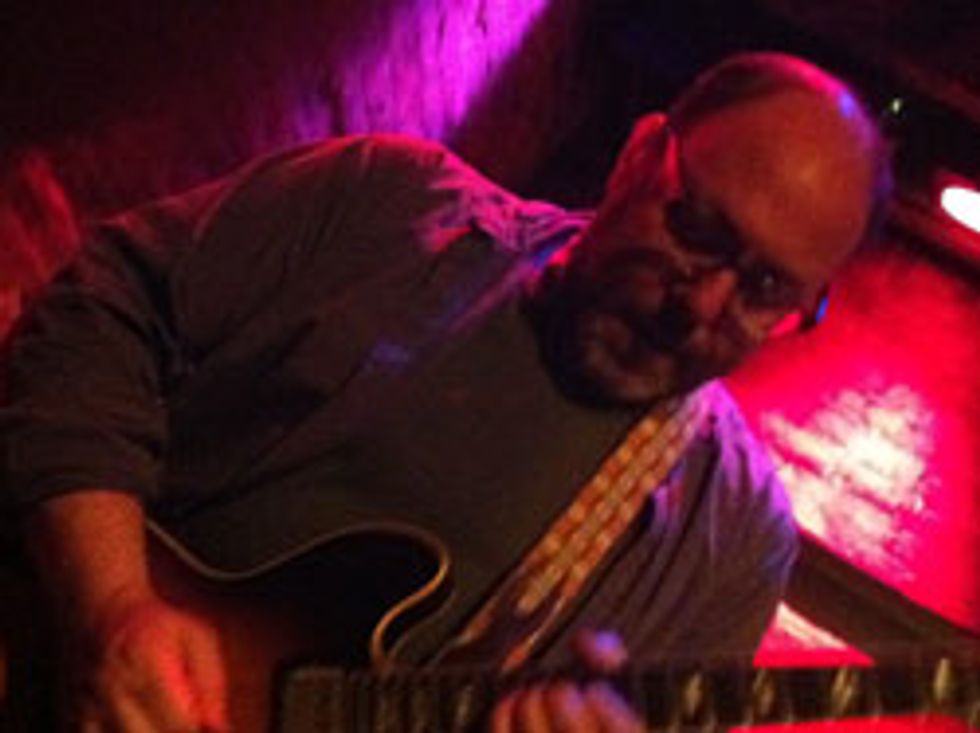
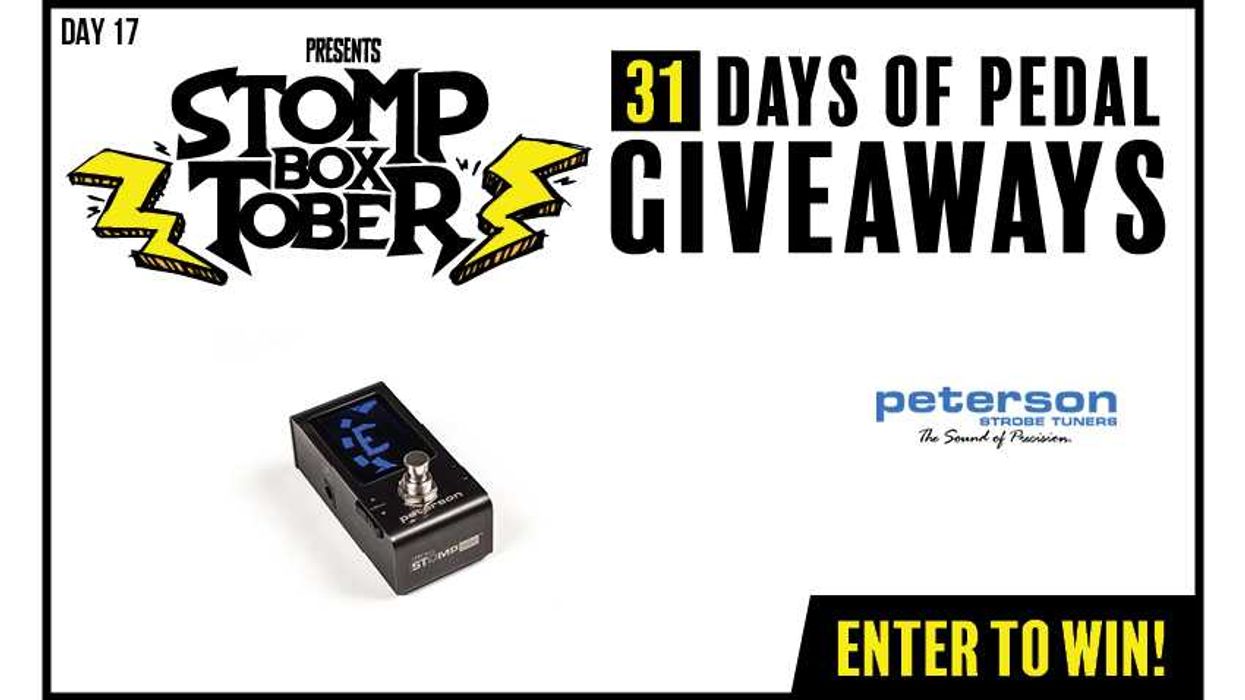

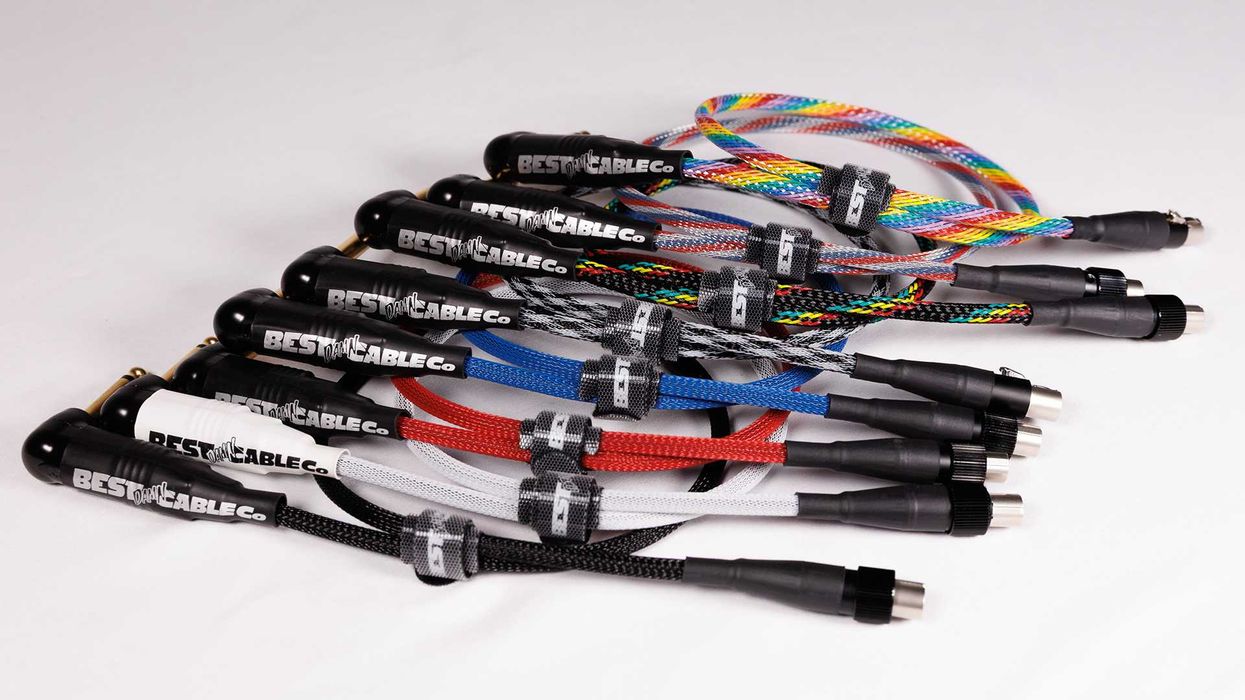

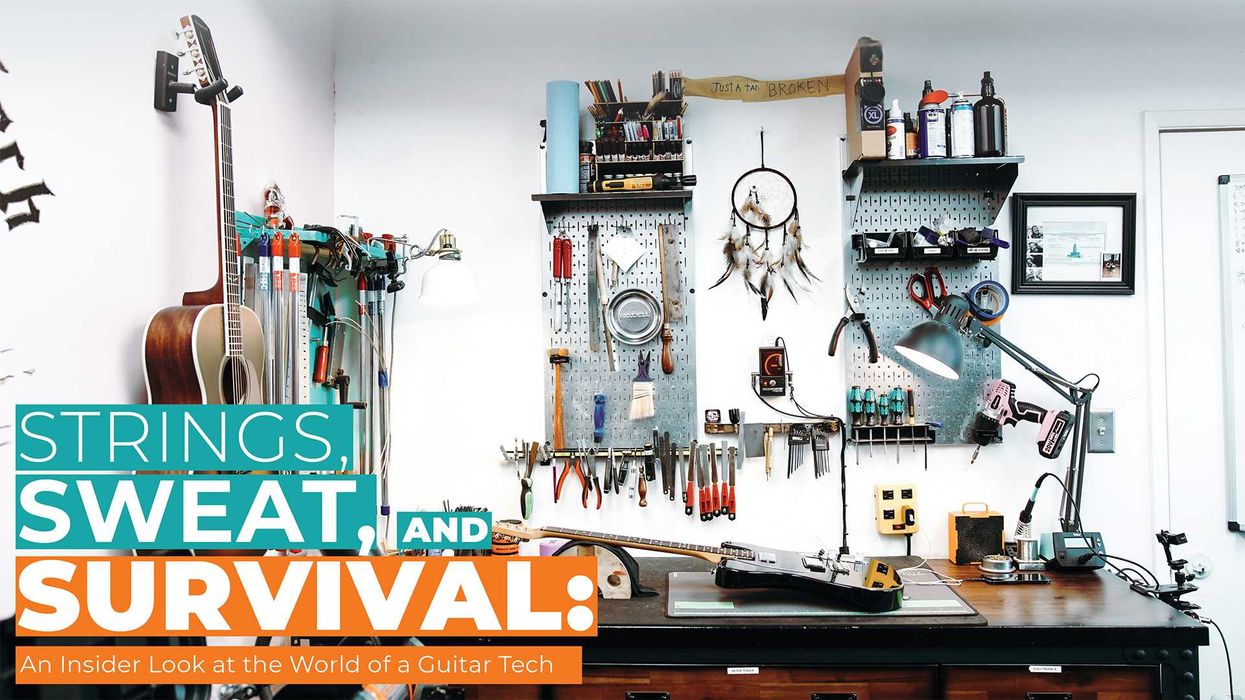
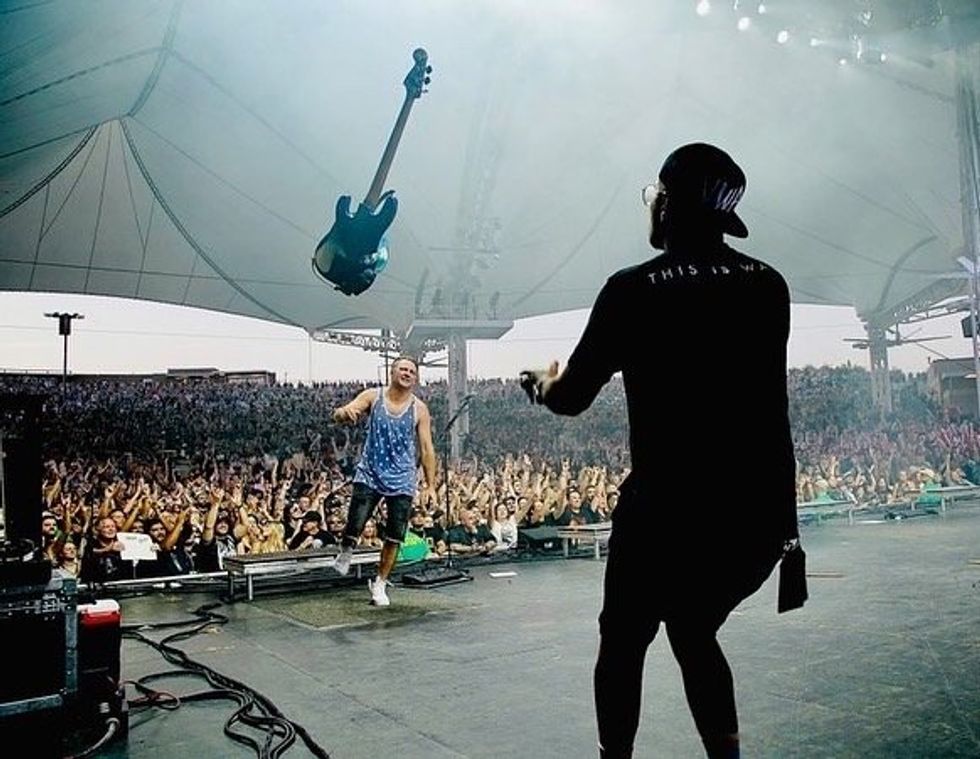 Luis Munoz makes the catch.
Luis Munoz makes the catch.